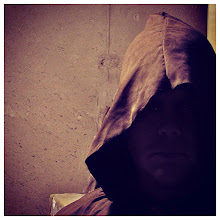I talked briefly about assembly 2 posts ago. As I mentioned, I build the markers first just with masking tape to the desired shape, then I spray "Great Stuff" expansion foam in between the pieces. It's much faster than spraying as you build, plus the adhesive works better when it expands to fill the cracks. Here is another pic of a built one:

Next is the shaping. Be warned; this step is unavoidably messy. The foam pellets get everywhere, are light as air so are hard to sweep and vacuum, and have static cling.
I know there are cutting tools you can buy, such as heated metal cords that cut through foam, but I've just been using a serrated knife and stiff-backed saw, putty knives, and my hands to shape it.
 Setting the image in is a tricky business. I mount my drawing to a panel with a glue stick (this is the best adhesive for the job I've used - it's dry, won't wrinkle the paper, and it applies easily). I then just push the image into place and mask it off once, overlap with cement patch, and immediately remove the mask so the patch doesn't dry with the tape under it. I mask it again, texture the cement, and it's ready for paint.
Setting the image in is a tricky business. I mount my drawing to a panel with a glue stick (this is the best adhesive for the job I've used - it's dry, won't wrinkle the paper, and it applies easily). I then just push the image into place and mask it off once, overlap with cement patch, and immediately remove the mask so the patch doesn't dry with the tape under it. I mask it again, texture the cement, and it's ready for paint.  Don't make the mistake I did here; whenever masking an image, use delicate adhesive blue painter's masking tape.
Don't make the mistake I did here; whenever masking an image, use delicate adhesive blue painter's masking tape.
I try to resolve shape as as possible to the desired final product. In fact, I keep this attitude through each step. I've observed as an artist that it is never a good idea to leave a step unresolved to be corrected later. When "later" comes, I find myself in repair mode, and the piece never gets to where I want it.
After shaping is finished, I measure out a space for the image and cut into it. I then do a quick layer of cheap latex paint over the whole thing. You can buy mismatched gallons from Home Depot for five bucks. This strengthens the surface for the texturing, binding all those foam pellets together so it's not a mess later.
For the texturing, I've found this acrylic-based concrete patch to work best:
It's stiff, gritty, and dries to a very strong, flexible surface. You can mix it with a little water to change up surface quality; you can even add pigment. It has that coarse, stony feel to it when it dries.
For this process, we wear latex gloves and hand-apply it, which I found works best. Once on, you can go back into and texture it using cloth, sponges, brushes or whatever you want. It dries relatively quickly, so I do this every square foot or so during application. Here's Amber in the process:
 Setting the image in is a tricky business. I mount my drawing to a panel with a glue stick (this is the best adhesive for the job I've used - it's dry, won't wrinkle the paper, and it applies easily). I then just push the image into place and mask it off once, overlap with cement patch, and immediately remove the mask so the patch doesn't dry with the tape under it. I mask it again, texture the cement, and it's ready for paint.
Setting the image in is a tricky business. I mount my drawing to a panel with a glue stick (this is the best adhesive for the job I've used - it's dry, won't wrinkle the paper, and it applies easily). I then just push the image into place and mask it off once, overlap with cement patch, and immediately remove the mask so the patch doesn't dry with the tape under it. I mask it again, texture the cement, and it's ready for paint. Don't make the mistake I did here; whenever masking an image, use delicate adhesive blue painter's masking tape.
Don't make the mistake I did here; whenever masking an image, use delicate adhesive blue painter's masking tape.Next step: painting.





No comments:
Post a Comment